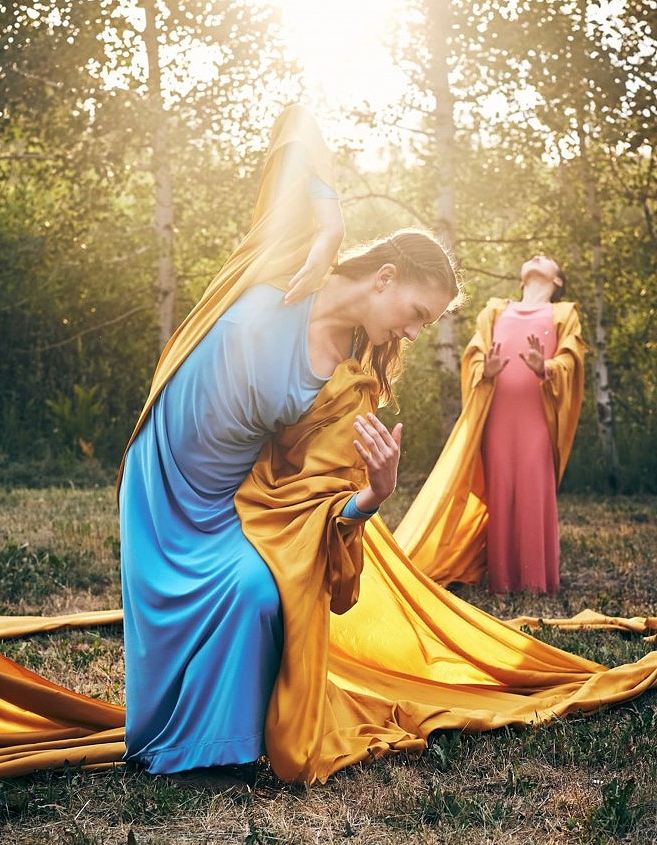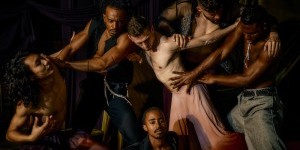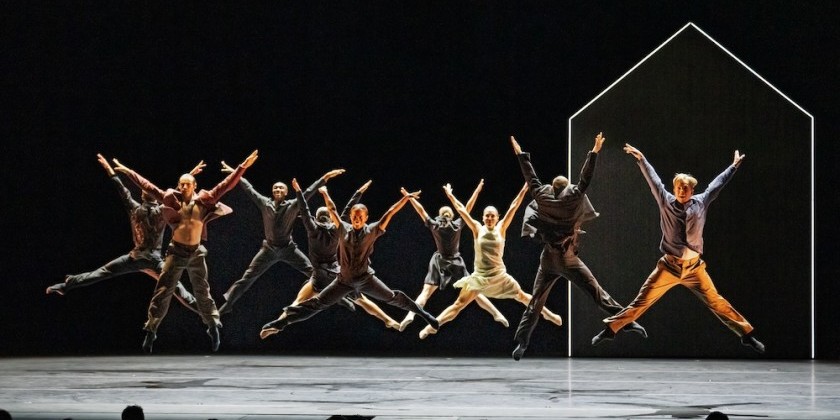THE DANCE ENTHUSIAST ASKS: Dante Puleio, Artistic Director of Limón Dance Company, about Limón's 75th Anniversary Season

Rarely Seen Limón Works, New Imaginings, and Bold Conversations with a Legacy
Talk about an odd time to start a new job — Dante Puleio came to his position as the artistic director of the Limón Dance Company just as New York City shut down thanks to a novel corona virus and ensuing global pandemic. Two years, and many Zoom and masked rehearsals later, he and the group are set to open their season at The Joyce Theater.
It's Puleio's first live season, the 75th anniversary of the company, with two different programs, two world premieres, revivals of work never seen on the company before, and also including guest artists from Trisha Brown, Kyle Abraham's A.I.M and and Bill T. Jones/Arnie Zane. And that's all happening for two weeks.

In other words, Puleio jokes, “you know, a low pressure, low stakes situation."
“Have you ever seen your dancers unmasked?” I ask.
“We still wear masks everyday in rehearsal,” he says. “I won't see their faces until we get to the Joyce. I’ll take no chances!”
Puleio and I spoke the evening after the mass-subway shooting in Brooklyn, an odd time for an interview about a New York dance season to be sure, but perhaps the perfect moment to speak about the healing power of the arts and what a 75-year-old legacy modern dance company has to offer audiences battered by world events. Below is just some of our conversation:

Christine Jowers for The Dance Enthusiast: Dante, thank you so much for speaking with me today. First of all, glad you are safe, and that we can both be here for this interview. I wonder, in light of the all the terrible events we’ve been experiencing: lockdowns, isolation, Covid and its many variants, numerous terrorist events, the politicization of everything, and war. Where and how do you feel you, the Limón Company, and dance fit in? What do you have to say to the world at this time?
Dante Puleio: Well, I came into this job during the pandemic, and it was the early pandemic, we were still about to go into that [presidential] election. And the world was so divided, you know, it was black or white. You believe this or you believe that. And I'm going through the repertory trying to onboard as much as possible. I follow in Carla Maxwell's footsteps, who danced with José and was the artistic director for thirty-eight years. So, how do I step into that in a way that I can still authentically bring Limón's story forward? Where are the lines of relevance that make this work make sense for this moment?

I was looking at one work for this season, Danzas Mexicanas, one of the first solos José made [1939]. It put him on the map as someone who had something to say, and knew how to say it. There's very little footage [of the piece] about two minutes, and while he writes about it in his unfinished memoirs, he also had a personal journal a Libro de Ideas (book of ideas) in which he wrote down the entire piece, all the steps —hands to the right, knees bent..etc. Each solo represents a different character from the Mexican Baroque era. José looked at the native peoples, the indigenous peoples, for El Indio, also the Conquistador, the Christian crusader; and, Peón, the slave; then the Caballero, the royalty: and finally, El Revolucionario, revolting against the paradigm. Bringing these solos back to life for this season, was a way for me to get to know José Limón better. I feel as if I'm growing up with him in this moment. He was figuring out who he was and what he wanted to say as a choreographer, and I am figuring out who I am and how I want to present his work to the world, as an artistic director.

Rehearsing Danzas Mexicanas; photo by Hisae Aihara
Going through this process, I discovered a person full of empathy. His lineage was both European and Indigenous. He understood and felt for the Indigenous peoples but he also felt and understood that the conquistadors were doing what they thought was right. These differing perspectives found a harmony and made peace within him. And man, if that's not a lesson we could all benefit from right now. The world is more nuanced; it’s not black and white, and with some understanding and forgiveness and compassion, we can start to build bridges instead of draw borders. That’s the jumping off point.
How did you come to the Limón technique, Dante? And, after your near decade of dancing with the company, did you ever think you would be its leader?
No. No. I mean, even coming to dance, was surprising. I didn't know that was something you could do. But once I started [late at 19], I knew there was nothing else I wanted to do. There was no other choice. I went to college, thinking I’d probably be a psychologist. I took dance as a prereq. for my theater minor. My teacher, Kristen Degnan, encouraged me to dance. I wanted to study abroad and she hooked me up with the Laban Centre in England. I remember I called my parents and said, “Mom, I think I want to be a dancer instead of a psychiatrist or a psychologist, what do you think about that?” She said,”You can always be a psychologist later. Go dance now!” From there, it was just dance classes and developing a discipline and, my passion for this.

I took a Limón class when I came home to finish my degree at University of the Arts, and I started to put the pieces together. “Oh, this isn't just a series of steps, this series of steps creates a form of expression. And oh, now I see how the momentum feeds the idea, and how the intention of what I'm doing creates the shape.” That all really came together for me with the Limón work.
After I retired, and finished my MFA, I stayed close to the organization because I cared about the work, I cared about my time there, and the people. When this opportunity came up, I was drawn to it. Drawn to the idea of seeing what was possible, what I could bring.
So, what is it that you bring?
I’m constantly hopeful that I'm making the right decisions. I have an amazing support system and so many people around me to bounce ideas off of and talk things through. Like today in rehearsal, for example, I had one person on Zoom and another person in the studio, and a live musician… All these people surrounding my company. Everyone was working hard while having conversations about art and understanding and the intention of the expression —it was so fulfilling just to be there and realize that I'm surrounded by the highest functioning artists in every aspect to bring José Limón’s legacy to life. It’s an amazing, amazing moment.

What did you know about José Limón when you came into the company?
Not enough. For me he was a historical figure who made great work. We got tidbits of information before we started rehearsing and I knew aspects of entry points…. Now I have more of an understanding. The weight of his journey, didn't really hit me until I got to this position. What might it have been like for this person, this man of color, in the mid 20th century to be creating dance In New York City, against so many odds of even being a person in the room.
How do you converse with the company about him?
Now the Limón elders, I call them my OGs, the early generations of dancers, they didn't get a lot of information from José. They were just making work. But that was different experience. When you're in the room with the person making the work you know what it's like, you “get it” because you’re with the force of nature creating it. I'm not bringing that to the table. If I were the choreographer that would be a different conversation. I have to figure out who José was, and give enough of his story so that the dancers can get underneath the repertory and feel as connected to the work as you know, Danny Lewis [Limón’s protegee] was. I want to give them as rich of an experience as Carla Maxwell, Sarah Stackhouse, and Clay Taliaferro had. I think that part is really interesting. It all goes back to that original concept that I wanted to be a psychiatrist or a psychologist.

Yes, finding what makes people and dances tick, and beginning new conversations for better understandings. Hmm. Speaking of new conversations. You’ve invited Olivier Tarpaga and Raúl Tamez to choreograph on the company. What do they have to say to Limón?
We were speaking earlier about José and his family escaping from his country [Mexico] during the Mexican Revolution, also the fact that he came from a musical family. Olivier Tarpaga, from Burkina Faso, grew up in a musical family, his father was a musician. He also grew up during a revolution and saw family killed. The formative life experiences that shaped Olivier, also shaped José. How interesting it is to pair these artists who had similar experiences. Even though they are continents and decades apart, there’s this thread. What makes an artist? What is about your formative years that shapes the stories you want to tell?

While Olivier was making this work called Only One Will Rise, I was watching him and watching the work. As it was taking shape it reminded me so much of José’s “Psalm.” This tribal ritual event that was lifting up one person was like watching "Psalm" happen from a whole other perspective. It’s the conversation. And, Olivier is amazing. I can't wait for the world to meet him. He’s so charismatic and fun. And he's a craftsman. he understands how to create new work that can stand shoulder to shoulder with the Limón repertory.

And he also created the music for his piece, right?
He made it on the dancers while the dance was happening in the studio, There were three musicians with him and would say ”Ok, give me some more this, give me this mood” It was a beautiful collaborative process that happened during COVID.
Tell me about Raúl Tamez. Is it true that he is the first Mexican choreographer since José Limón to set a piece on the company? Really?
I keep saying this, hoping that someone will come up to me and say, “No, you’re wrong, there really was this other person." Maybe someone will, but until they do…

Raúl has beautiful background that's really interesting. He has ties to both a classic and contemporary Eurocentric perspective , the NDT, Pina Bausch world influence. He also has a good understanding of Folklorico and Indigenous languages and dances. He's a sociologist who has done much studying outside of dance and incorporates that research into his work. So, he can have real dialogue about colonization, and its impact on the Mexican people. He had a very different working process than what we're used to. There was a lot of conversation. There was a lot of improvisation work, deep improvisation .
José made a piece called Tonantzintla in 1951. It is about nine minutes long and it celebrates the Mexican baroque architecture of this one little church, Santa María Tonantzintla, located in San Andrés Cholula, Mexico. The place has a rich cosmology, lots of gold and curls and beautiful angels. And also within it, you see different iterations of generations of religion that existed before there was a Christian belief in Jesus. Those ideas exist in the church and inside of this work. You see a little brown baby Jesus, then you see a blonde, baby Jesus; you see, the arc of the history of colonization.

Jose's piece celebrates this. It is a beautiful, fun, nice. little piece. Raúl's Migrant Mother, looks at the darker underbelly of colonization. What did that actually do to 300 years, and to generations and generations of people. And what does colonization look like on the body? What happens when your family is taken from you? What happens when you're trying to emigrate? What happens to the body in these moments? What is that story?
In order to access that kind of storytelling from the dancers, they had to go very deep. You know, rehearsal doors, were shut. Lights were kept dim. The research was personal, Raúl would give challenging tasks that required the dancers to dig to dark places so they could authentically bring these stories to life.
It’s different than when we're looking at a Limón work, where we are sharing generations of steps. This person interpreted the dance this way. "Let’s try this. What is the intention?" It’s deep work as well. Raúls work comes from a different place, but through his process we are able to find new ways to access our Limón heritage. Each commission, brings us closer to Limón in new ways —rooting ourselves in his legacy and pushing that work forward in important and authentic ways.
Tell me about some of the highlights of the season, I understand you have two programs one for each week. What can the audience expect?
So week one: Air for the G String by Doris Humphrey [1928], I want to make sure that each season I have something of Doris's in the rep for context. Who was José? Well, he got his craft from and developed with this person. So having her story inside of our program is important. This will be followed by Psalm [1967] a major revival, first time with the original score in over 40 years. New costumes, really upping the production value of it. We went back to the original film, and reworked that version, versus using Carla [Maxwell's] version from 2002, which was amazing. We do use a lot of that, but we’re restructuring the narrative a bit so it makes more sense for this moment. It's Psalm as you haven't seen it before.

Then there’s a little intermission: hang out, talk, catch up. The second act starts with the solo, Chaconne [1948]. Limón was a great dancer, coined the greatest dancer of his time, so it's important to have some of the greatest dancers of our time,not in the Limón company, as part of our story. Let's bring other dancers into the fold. We’ve invited Shayla-Vie Jenkins, originally from Bill T. Jones/Arnie Zane Dance Company, Donovan Reed, from Kyle Abraham’s A.I.M, and Amanda Kmett’Pendry from Trisha Brown. And they look stunning.
We finish the program with Olivier Tarpagas, Only One Will Rise. There’s live music onstage and it ends the night with big energy. It’s just a gorgeous piece. Yeah, I'm really proud of program. If you don't know dance well, and you want to, I think this is a great program. It's accessible. There’s great storytelling happening. And you get to understand the structure of Limóns work by seeing the architecture of his solo work and big group dances. There’s Doris Humphrey, and then a new voice —beautiful.

Program B is Week two. We start off with Waldstein Sonata, [1971/1975 started by José Limón and finished by Daniel Lewis] the last work José made, and this is the first time the Limòn Dance Company is performing it. We have beautiful costumes, a live pianist, it's gorgeous. Then we go to Danzas Mexicanas [1939] one of the first solos José ever made.

I was wondering how to connect his last work —Waldstein... —a very Eurocentric, Beethoven, technical, really specific aesthetic— to the piece by Raúl Tamez with its dark view of colonization. What could bridge these two works was Jose's integration of these different perspectives in his life. That’s what made Danzas Mexicanas come to mind. We see the Eurocentric approach and see how it lived in José, and and then we go into a contemporary artist talking about the themes which we're all considering and aware of now, Raúl's Migrant Mother.
It seems like a thrilling two weeks. Anyone who loves dance, or who’s curious about movement, culture, heritage and well, people, should come and see. It also sounds like it has a bit of bite, an edge?
I think Program B is going to be very exciting, especially for people who identify in the Latin X-world. People come in through this heritage to see Limón’s story come to life through his heritage. It’s important to see. And Raul's work challenges you. There are some adult themes with language and such, and it’s important for our audience to know that it's not light. Migrant Mother, definitely pushes buttons and is not afraid to back down from what it's saying.
Limón Dance Company at The Joyce Theater
Program Details:
April 19- May 1, 2022
Program 1: Tuesday, April 19- Sunday, April 24
(Tues/Wed 7:30 PM; Thurs/Fri 8 PM; Sat 2 PM & 8 PM; Sun 2 PM)
Program 2: Tuesday, April 26- Sunday, May 1
(Tues/Wed 7:30 PM; Thurs/Fri 8 PM; Sat 2 PM & 8 PM; Sun 2 PM)
Curtain Chat: Wed, Apr 20 Family Matinee: Sat, Apr 23 at 2pm
Location: THE JOYCE THEATER, 175 Eighth Avenue New York, NY 10011
Tickets: $10-$75
Tickets: https://www.joyce.org/performances/limon-dance-company
Call JoyceCharge at 212-242-0800 for $10 tickets. All other tickets can be purchased online.
*The Joyce is requiring audiences to be fully vaccinated and to wear masks at performances. Click here for full health & safety protocols.












